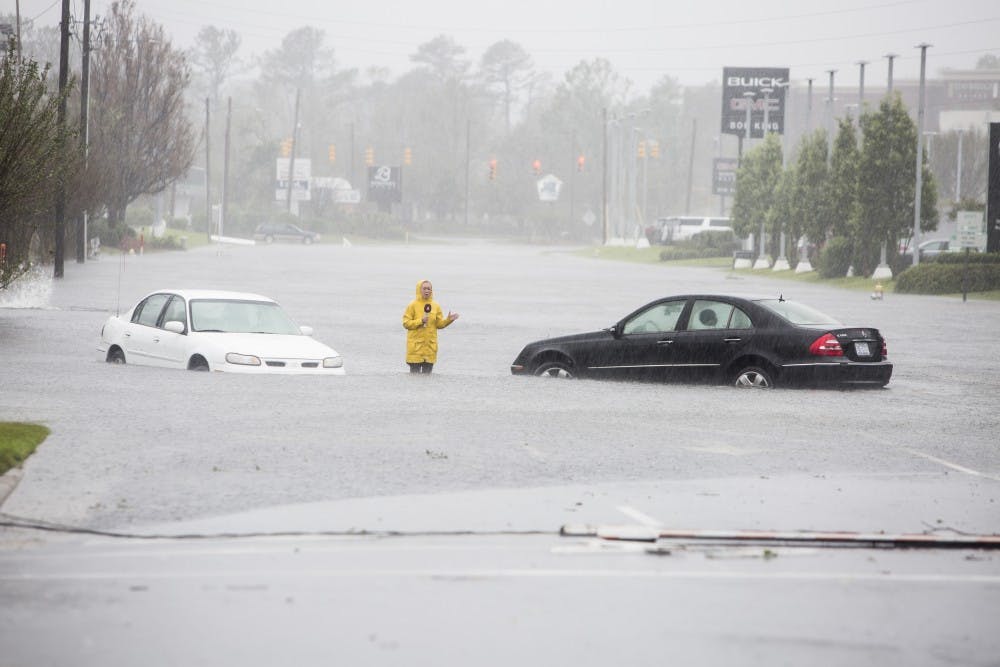“Our entire bottom floor was flooded,” Tyson said. “My family stayed there, but I went to stay with friends in Charlotte.”
Due to road closures, some students, including Stoner, had to use alternative means of returning to campus. But he said he was "lucky not to get hit too bad.”
Long-term effects of Florence
Hans Paerl, a distinguished professor of marine and environmental sciences at UNC's Morehead City-based Institute of Marine Sciences, is studying the long-term effects of hurricanes as the supervisor of two monitoring programs conducted in the Pamlico Sound and the Neuse River.
“We’ve learned from previous storms that sometimes these events take months to play out,” Paerl said. “In the case of major storms like Florence last year, we’re still seeing ramifications of those events a year later in terms of the amount of organic matter and nutrients that got dumped in the Pamlico Sound.”
Paerl said this past spring, his lab found unusually early algal blooms that extended into the summer, which can lower oxygen levels and produce more toxins in the waters.
“They will essentially cause a strong stratification of the estuary, and if there’s enough freshwater sitting for a long enough time on top of saltwater, it can lead to pretty serious issues such as fish kills and shellfish deaths,” Paerl said.
Hurricane Florence raised further questions for his research team, which has experienced multiple hurricanes in the past few years.
“In many ways, we are in uncharted areas,” Paerl said. "We know that the frequency of these events is increasing and the rainfall associated with these events is increasing, so the system is being perturbed in an increasing way. We know these systems take months and sometimes years to recover.”
Ongoing recovery in Chapel Hill
Ran Northam, community safety communications specialist for the Town of Chapel Hill, said recovery efforts in Chapel Hill are still ongoing a year after the storm.
“There are some processes that are currently in place to receive federal funding for the recovery efforts,” Northam said in an email. “Those processes have not been completed yet. It takes a long time to get the paperwork in and get the funding back, so we have not yet received that funding.”
To get the day's news and headlines in your inbox each morning, sign up for our email newsletters.
Although certain funds are still coming down the pipe, there are no physical recovery efforts happening because the Town was able to fix last year's damage, he said.
But the cleanup and response to Hurricane Florence has been used to inform procedures for subsequent storm events.
“Our policies, procedures and strategies are always changing and evolving for emergency response,” Northam said. “One thing that the town has been working on since Hurricane Florence is internal messaging — how we communicate with our town employees on closing down facilities, and whether people need to come to work when there’s a hurricane."
The statewide response
More than $100 million was distributed to more than 700,000 people in North Carolina who use the Disaster Supplemental Nutrition Assistance Program, said Kelly Haight Connor, press assistant for the Office of Communications at the N.C. Department of Health and Human Services.
But the storm caused threats to public health that were harder to detect.
“Excessive rains and flooding can cause water in your private well to become contaminated, meaning the water can cause adverse health effects if it is consumed or comes into contact with the skin,” Haight Connor said in an email. “After Hurricane Florence in 2018, nearly 45 percent of wells tested by the State Public Health Lab were found to have bacterial contamination. More than 13 percent of these wells had detectable E. coli.”
In addition to pathogens in drinking water, disease-carrying insects, such as mosquitoes, can see population booms due to long periods of standing water. Gov. Roy Cooper directed $4 million to fund mosquito control efforts in counties under major disaster declarations.
“NCDHHS is working with local health departments to remind people that after a storm, large populations of mosquitoes can emerge days to weeks after heavy rains or flooding,” Haight Connor said. “Areas of standing water can also increase the number of mosquitoes. Most are ‘nuisance’ mosquitoes, but some can carry viruses that may cause illnesses such as La Crosse encephalitis, West Nile virus and eastern equine encephalitis.”
While recovery efforts are ongoing across the state, officials are urging residents to take precautions before a storm hits to mitigate damages.
“The other thing we constantly tell people is to have a preparedness plan, to always be able to respond to any kind of weather emergency, to be able to take action immediately so that they’re not creating a plan 24 hours before a storm is going to arrive,” Northam said.
NCDHHS is using similar recovery efforts in the wake of Hurricane Dorian.
“Many families will feel the effects of this disaster long after the storm has passed, and we will continue to support them in any way possible in the weeks and months ahead," Haight Connor said.
@MichaelJTaffe
city@dailytarheel.com
special.projects@dailytarheel.com



